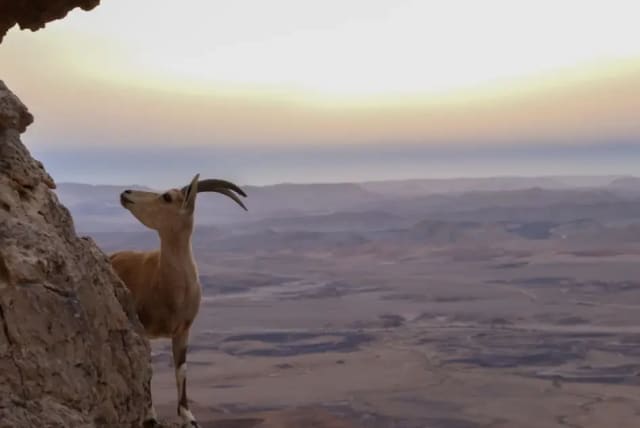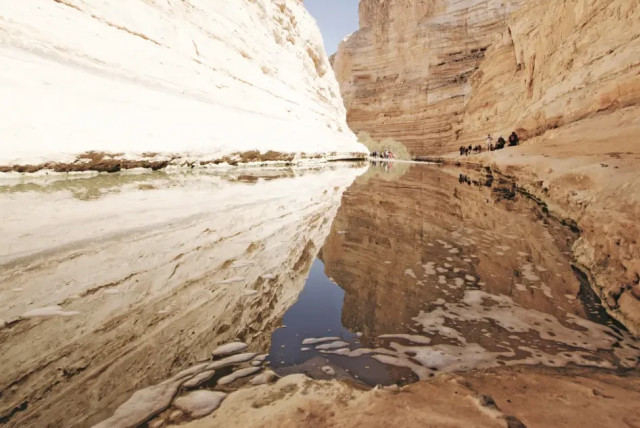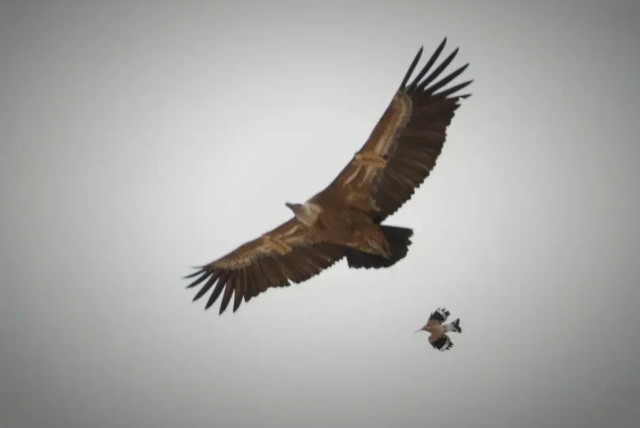A day in the historic nature of the Ramon Crater

Explore the historic wonders of Ramon Crater and its rich biodiversity, a must-visit destination for nature enthusiasts and families alike.
In the rugged expanse of the Negev Desert lies a hidden gem of natural wonders: Ramon Crater. This vast geological wonder provides a glimpse into different periods in history and is filled with a rich variety of flora and fauna, making it an attractive destination for nature lovers. From snakes and lizards to unique raptors, goats, jackals, foxes and deer - the crater is home to a captivating variety of wildlife. These days, the crater comes to life and this is perhaps the most beautiful time of the year to visit it - the spectacular nature photos will testify.
The crater was even recognized as a Starlight Reserve, the first site to be recognized as such in the Middle East, making it rare on a global level. In these complex days, the endless desert and the changing landscape of the area give a sense of stability and peace, and the crater itself, formed over millions of years, gives a sense of certainty despite continuous change.
"When you stand at the edge of the crater and observe its breathtaking panorama, it's hard not to want to discover more and more parts of it. Beyond its picturesque scenery, the crater contains ancient geological wonders, flowers of rare beauty, and a magical wilderness that can hardly be described in words," said Oded Sahar, director of the sites of East Mount Ramon in the Nature and Gardens Authority. "These days, individuals, families and groups return to enjoy trips in the Ramon Crater, the Genesis landscape allows us a small piece of peace in difficult days, I am happy to see your return and wish you a pleasant time in nature," he added. With the help of the Nature and Parks Authority, we have prepared some recommended destinations for you when you go out to explore the magic of the crater.
Ein Avdat National Park
The first destination you should reach when you come to Makhtesh is Ein Avdat - or by its other name "The Kingdom of the Goats and Eagles". It is an oasis of spectacular beauty - offering breathtaking cliffs, springs and picturesque nature. The eye is actually part of Nahal Tzin, which created a narrow, deep and impressively beautiful canyon, through which the spring water flows. The water of the spring turns into a waterfall that rises 15 meters, which spills into a large and spectacular pool. On its banks you can admire the breathtaking vegetation and many wild animals, among them goats and eagles. At the top of the mall you can enjoy an observation deck with a panoramic view of the impressive area.
Avdat National Park
Not far from there is the ancient city of Avdat - recognized as a world heritage site. It is a Nabatean city with rare antiquities from the Byzantine period, which reveals an exciting facet in the human history of the Land of Israel. You can visit the citadel and the historic churches, observe the remains of a stable, water cisterns and a magnificent Roman burial cave. A trip to Avdat will provide you with an enriching, educational and exciting experience in the heart of the crater.
About a year ago, a research vineyard based on heritage varieties unique to the Negev from thousands of years ago was also opened in Avdat, which was replanted in the National Park. We are talking about varieties unique to the Negev, from which they made the Negev wine that gained a reputation all over the Mediterranean Sea and beyond during the first millennium AD. The restoration of the lost vines to the Negev strengthens the identity of the Negev as a desert wine region with deep historical roots.
Write in Waze: National Park Avdat
When: Sunday-Thursday and Saturday: 08:00-16:00 | On Fridays and holiday eves: 08:00-15:00.
Mitzpe Ramon
Ramon Crater nature reserve and visitor center
In the center of the Negev Mountain and on the edge of the crater, the real magic of the crater happens. The first stop you should go to before a trip to the depths of the crater is the nature reserve and visitor center of the Nature and Parks Authority. Between spectacular rock walls, the center offers an enriching experience that connects you to the deep roots of our spectacular country. In the center that rises above the nature reserves of the Tzin Cliffs and the Negev Mountain, you will learn in depth about the historical charm of the crater, and about its unique landscape and geological phenomena. At the center you can watch a film that provides an overview of the life of the first Israeli astronaut - Ilan Ramon, and learn about his journey into space. And in another film that provides a unique glimpse into the exciting, diverse and hidden nature of the desert.
This is an important milestone for anyone who wants to be equipped with essential information about the crater and travel options in the area.
Write in Waze: Ramon Crater Nature Reserve and Visitor Center.
When: Sunday-Thursday and Saturday: 08:00-16:00 | On Fridays and holiday eves: 08:00-15:00.
The sawmill track
On your way out of the center, it is recommended to visit the sawmill route, one of the favorite and well-known routes in the crater - and you should do this precisely in the winter season, when the crater is painted in unique colors and takes an impressive turn of breathtaking beauty, full of colors, flowing streams, and spectacular eagles.The sawmill is actually a sandstone hill, on top of which sandstones are placed in a pile - this is a rare geological phenomenon in itself, and you can watch it through a floating bridge created especially to protect the rare sandstones that have been preserved for thousands of years, and turned into prismatic quartzite columns.Write in Waze: The sawmill
Ramon Crater Colors National Park
If the beauty of the sawmill route left you curious and yearning for more - the next destination that you must stop at is the Ramon Crater Colors National Park. As its name implies, the garden offers a glimpse into a colorful world of colorful rocks, an open quarry wall mine that demonstrates rocks that were formed about 200 million years ago, and have an oval and unique color to the entire crater. It is a fascinating trip back in time, offering spectacular views that are second to none. Inside the garden you can look at the wonderful purple canyon, the open mine that turns into a beautiful lake in the winter, the underground mine and many other viewpoints.
Write in Waze: Ramon Crater Colors National Park
When: The garden is open from sunrise to sunset.
Parsat Nekarot and Ein Saharonim
Towards the end of the experiential and wonderful day in the heart of the crater - you should stop for a night camping at the Be'erot parking lot, one of the many parking lots in the crater and the one that offers the most extensive infrastructure, as well as a magical view of an open sky full of stars - a view that is difficult to capture in the modern age in which we live. But before settling down with tents, and as long as the sun is still shining on the watchtower, it is highly recommended to visit Farsa Nekroun and Ein Saharonim, for a perfect end to a day trip to Makhtes.
The Nekarot stream, which flows into the Arava stream, is one of the largest among the streams of the Negev Mountain, along which there is a bend known as "Parsat Nakrot" - this is a unique area that presents the cliff walls of the limestone rocks that border the stream and give it a magical and miraculous feeling. Further down the woodpecker's horseshoe, the water of the stream is compressed into a narrow and impressive gorge, and a hidden cave formed by the drifting of the soft material from the base of the cliff during the floods.
Ein Saharonim: Ein Saharonim is a small spring, fed by groundwater and floods. The spring is found at the connection between Nahal Ramon and Nahal Nakerot, and next to the dangling and spectacular Saharon plant that gave it its name. It is a natural and central water place in the heart of the crater, therefore beyond the impressive vegetation, which includes common reeds, ash trees and sahron bushes, it is a meeting place for the rich variety of wildlife living in the crater. You can look at goats, wild donkeys and a rare variety of birds that live around the spring.
Write in Waze: Ein Saharonim
Jerusalem Post Store
`; document.getElementById("linkPremium").innerHTML = cont; var divWithLink = document.getElementById("premium-link"); if (divWithLink !== null && divWithLink !== 'undefined') { divWithLink.style.border = "solid 1px #cb0f3e"; divWithLink.style.textAlign = "center"; divWithLink.style.marginBottom = "15px"; divWithLink.style.marginTop = "15px"; divWithLink.style.width = "100%"; divWithLink.style.backgroundColor = "#122952"; divWithLink.style.color = "#ffffff"; divWithLink.style.lineHeight = "1.5"; } } (function (v, i) { });



